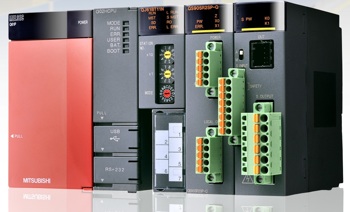Safety relay clips into a PLC rack
Mitsubishi has developed a safety relay that clips into a PLC rack, making detailed information available on the condition of the relay and the status of any connected safety circuits. The QS relay is also available in a standalone version that connects to the high-speed CC-Link network.

Both versions allow detailed safety circuit status to be transmitted to a control system – something that is not possible using traditional safety relays.
According to Jeremy Shinton, Mitsubishi’s Q Series product manager in the UK, the relay was developed in response to requests from customers for a technology that was more intelligent than a traditional safety relay, but cheaper and less specialised than a safety PLC.
“Typically, a manufacturing plant will have a number of safety circuits on it, each with its own standalone safety relay protecting one particular aspect of the process,” Shinton explains. “If one of these circuits trip, the whole plant may be effectively shut down and production lost while engineers inspect the machine or process line looking for the appropriate relay and circuit to identify its cause and correcting the reason before restarting operations.”
The new relay addresses this problem on two levels. First, the tripped circuit is identified instantly at the control system and can be shown on HMI, SCADA or panel indicators. And second, a history of trips and their causes can be logged and analysed, allowing recurring issues to be indentified and addressed.
The relay is also designed to deal with the problem of nuisance trips which account for about half of all safety shutdowns. Typically, these are caused by someone brushing against an E-stop or breaking a light curtain accidentally. The stoppages disrupt production while the cause is sought. The new relay will help to identify the problem quickly, allowing production to resume without delay.
The QS safety relay is designed to sit on Mitsubishi’s Q series PLC rack and to integrate with a plant or machine control system. It is powered independently from the PLC, so if the PLC fails, it will not affect the safety circuit.
“The fact that installation is as simple as clipping a standard module onto a PLC rack or a DIN rail, and that no programming is involved, means there is no learning curve,” Shinton says.
Several QS relays can be included in one PLC rack, each supporting up to three extension relays connected to field devices such as switches, light curtains, and interlocks. Larger safety systems can be implemented by networking the PLCs.
Data from the relays can be linked to higher-level control systems and to systems that generate management information. The QS monitors eight variables per connected safety circuit, including the status of the safety inputs and outputs, and of the relay coils and contacts.
The standalone version is connected via CC-Link to a host PLC and also supports up to three extension relays and allows multiple relay stations to be configured. The safety circuits can be “zoned” so that a safety trip shuts down only the relevant part of the plant.
The safety relay has been certified by TÜV, and is suitable for Category 3 and 4 installations. It has also been certified to the new EN ISO13849-1 standard and meets performance level “e”.
The QS safety relay is the first in a series of safety products that Mitsubishi is planning to launch, taking it into new fields. It reckons that the UK safety market is worth around £20m.

